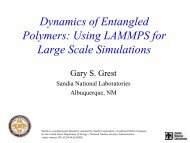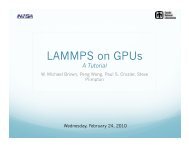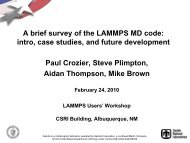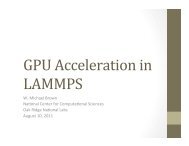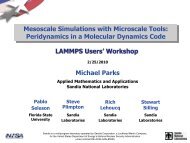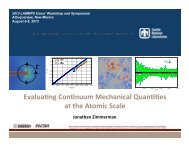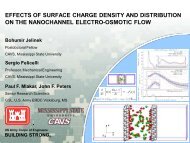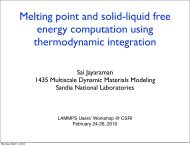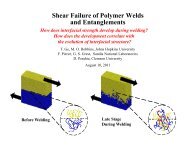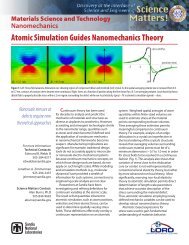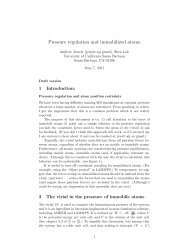Applications of GPU package to soft matter simulations - Lammps
Applications of GPU package to soft matter simulations - Lammps
Applications of GPU package to soft matter simulations - Lammps
You also want an ePaper? Increase the reach of your titles
YUMPU automatically turns print PDFs into web optimized ePapers that Google loves.
Scientific Computing group, National Center for Computational Sciences, ORNL LAMMPS Accelera<strong>to</strong>r Library • Available in LAMMPS as "<strong>GPU</strong> Package" • Support for many commonly used pair styles – Pair-wise potentials, – Three-body potentials: EAM, Stellinger-Weber, – Particle-Particle Particle-Mesh • Multiple MPI tasks share available Accelera<strong>to</strong>rs – Still get parallelization on CPU and compatibility with other LAMMPSfeatures • CPU/Accelera<strong>to</strong>r concurrency for force computation• CUDA and OpenCL compatibility via a generic API (Geryon) Brown, Wang, Plimp<strong>to</strong>n, Tharring<strong>to</strong>n, Comput. Phys. Comm., 182, 898-911, 2011 Brown, Kohlmeyer, Plimp<strong>to</strong>n, Tharring<strong>to</strong>n, Comput. Phys. Comm., 183, 449-459, 2012 Brown, Yamada, Comput. Phys. Comm., To Appear, 2013
Scientific Computing group, National Center for Computational Sciences, ORNL ORNL Computing resource Jaguar Cray XK6 (2011) 18,688 nodes: • 16-core AMD Opteron 6200 • 1 NVIDIA Tesla X2090 (Fermi) • 32 GB RAM Gemini interconnect (75 Gbits/s) Titan Cray XK7 (2012) 18,688 nodes: • 16-core AMD Opteron 6274 • 1 NVIDIA Tesla K20X (Kepler) • 32 GB RAM
Charged polyelectrolytes • Objectives:– Structural and dynamic features as a function <strong>of</strong> the distancebetween two grafted surfaces • Computational challenges: – Long-range solver with sparse charges – Slab geometry; periodicity in z undesirable • Resolutions – Longer cut<strong>of</strong>f for real-space calculations (<strong>GPU</strong>) + coarser mesh fork-space calculations (CPU): 3x (<strong>GPU</strong> vs CPU-Only PPPM onXK6) – Truncated shifted-force Coulombic potential (lj/cut/coul/dsf) forsystems <strong>of</strong> uniformly distributed charges: ~12x (<strong>GPU</strong> vs CPU-Only PPPM on XK6) Fennel, Gazelter, J. Chem. Phys., 124, 234104, 2006 Carrillo, Russell, Dobrynin, Langmuir, 27, 14599, 2011 Scientific Computing group, National Center for Computational Sciences, ORNL
P, k B T/ 310 -2Disjoining pressure vs. gap 10 -1 10 1 10 2DSF r c = 10DSF r c = 20DSF r c = 30P 3 Mv y , /Time, seconds10 -110 -2100(a) zz = 3.46×10 -2 k B T/ 310 0 10 -4 10 -3 10 -2101DSF r c = 10DSF r c = 20P 3 M(a)Sliding velocity vs. shear stress v y , /10 1 10 -4 10 -3 10 -210 010 -1DSF <strong>GPU</strong> r c = 10DSF <strong>GPU</strong> r c = 20DSF <strong>GPU</strong> r c = 30DSF <strong>GPU</strong> r c = 40P 3 M <strong>GPU</strong> 10 -5P 3 M CPU(b) zz = 3.46×10 -3 k B T/ 3DSF r c = 10DSF r c = 20P 3 M10 -3D, Model: - Polymer chains randomly grafted<strong>to</strong> opposite surfaces - Charges on brush monomers;neutralizing counterions freelyfloating Simulation:- NVT (Langevin thermostat) Scientific Computing group, National Center for Computational Sciences, ORNL 10 -3Time, seconds0.11010.11 2 4 8 16 32 64 yz , k B T/ 3Nodes10 -2Performance (c)1 2 4 8 16 32 64NodesNguyen, Carrillo, Dobrynin, Brown, J. Chem. Theory Comput., 9, 73-83, 2013 yz , k B T/ 3DSF <strong>GPU</strong> r c = 10DSF <strong>GPU</strong> r c = 20DSF <strong>GPU</strong> r c = 30DSF <strong>GPU</strong> r c = 40P 3 M <strong>GPU</strong> 10 -5P 3 M <strong>GPU</strong> 10 -2
Scientific Computing group, National Center for Computational Sciences, ORNL Lessons learned • Shift the computational work <strong>to</strong> real-spacecalculations by increasing cut<strong>of</strong>f • Use verlet/split <strong>to</strong> perform k-space and real-spacecalculations concurrently • Use <strong>GPU</strong> acceleration <strong>to</strong> decrease the number <strong>of</strong>MPI tasks performing long-range calculations • Increase the number <strong>of</strong> threads per a<strong>to</strong>m with thereal-space cut<strong>of</strong>f • Enhanced truncation methods are accurate forcertain systems but need further work <strong>to</strong>characterize charge screening in condensed phase
Liquid metallic rings and stripes • Objectives:– Competition between instability and surface tensionminimization that leads <strong>to</strong> breakup or collapse <strong>of</strong> thin rings andstripes on a solid substrate.• Computational challenges: – Many-body interaction between liquid a<strong>to</strong>ms (modeled by theEAM potential) • Resolution – EAM (liquid-liquid) and LJ (solid-liquid) are performed on <strong>GPU</strong>s – Performance gain: ~3-4x (<strong>GPU</strong> vs CPU-only on XK7) Brown, Nguyen, Fuentes-Cabrera, Fowlkes, Rack, Berger, Bland, Procedia Computer Science, 9, 186, 2012 Scientific Computing group, National Center for Computational Sciences, ORNL
t c(ps)Model: - Liquid a<strong>to</strong>ms interact via Cu EAM - Liquid-substrate a<strong>to</strong>ms interact viaLennard-Jones 12-6 - Substrate a<strong>to</strong>ms are immobile Simulation:- NVT (Nose-Hoover thermostat) - N = ~100K a<strong>to</strong>ms; up <strong>to</strong> 64 nodes 500400300CMMDt c(ps)300200W = 10ÅW = 30ÅW = 35ÅW = 10ÅScientific Computing group, National Center for Computational Sciences, ORNL a)b)CMMDBreakup vs. collapse 200100 W = 30Å110ps!100(a)(b)R=160A00W = 35Å100ps!0 20 40 60 80 100 120 0 20 40 60MD vs. continuum l (A) hydrodynamic <strong>simulations</strong> W (A) 250250W=10A (breakup)W=35A (collapse)CM20020060MD15015040100100CM2050(c)50(d) MD0000 50 100 150 200 250 0 50 100 150 200 250t (ps)t (ps)Nguyen, Fuentes-Cabrera, Fowlkes, Diez, Gonzalez, Kondic, Rack, Langmuir, 28, 13960, 2012 r m(A)r m(A)R=200Aw (A)70ps!130ps!170ps!70ps!500ps!500ps!500ps!500ps!500ps!500ps!
Lessons learned • Performance gain with <strong>GPU</strong> acceleration forEAM is modest because <strong>of</strong> the short-rangedEAM (0.5 nm for Cu) and an additionalcommunication for electron density • processors and fix balance are helpful forload balancing. Scientific Computing group, National Center for Computational Sciences, ORNL
Liquid crystal dewetting • Objectives:– Dewetting <strong>of</strong> liquid crystal films • Computational challenges: – Anisotropic interaction between liquid crystal molecules • Resolution – Gay-Berne interactions are performed on the <strong>GPU</strong>s – Performance speedup: >7x (<strong>GPU</strong> vs CPU-only onXK7) Brown, Nguyen, Fuentes-Cabrera, Fowlkes, Rack, Berger, Bland, Procedia Computer Science, 9, 186, 2012 Scientific Computing group, National Center for Computational Sciences, ORNL
Scientific Computing group, National Center for Computational Sciences, ORNL yModel: - 3:1 LCs interact via Gay-Berne - Spherical substrate a<strong>to</strong>ms are immobile 9008007006005004003002001000t = 18100000t = 53500004000t 71000001800t = 5350000h 0 = 4σ 0 h18000 = 6σ 0 h 0 = 8σ 0 160035000 100 200 300 400 500 600 700 800 900xyy160014001400120012001000100080080060060040040020020000-200-200 -200 0 200 400 600 800 1000 1200 1400 1600 1800-200 0 200 400 600 800 x 1000 1200 1400 1600 1800xSimulation:- NVT (Nose-Hoover thermostat) - fix ave/spatial N = 10-30M LC molecules + ~10M substrate a<strong>to</strong>ms; 400-4900 nodes Film thickness h(x, y) y3000250020001500100050000 500 1000 1500 2000 2500 3000 3500Nguyen, Carrillo, Brown, in progress xExperiment: Isotropic films <strong>of</strong> 5CB LCs dewetting Vandenbrouck, Valignat, Cazabat, Phys. Rev. Lett., 82, 1999
Lessons learned • Optimal number <strong>of</strong> MPI tasks sharing a <strong>GPU</strong> is 4• Optimal number <strong>of</strong> a<strong>to</strong>ms per <strong>GPU</strong> is ~15-30K • Use LAMMPS enhanced MPI task placement forCartesian grid (via processors grid numa) • Use the CUDA Proxy server on Titan so MPIprocesses can efficiently share the <strong>GPU</strong> – Compile lib/gpu with –DCUDA_PROXY and 'exportCRAY_CUDA_PROXY=1' on Titan Scientific Computing group, National Center for Computational Sciences, ORNL
Scientific Computing group, National Center for Computational Sciences, ORNL Summary • <strong>GPU</strong> <strong>package</strong> can <strong>of</strong>fer 3-7x speedup • Coulombic interactions • Many-body interaction (EAM) • Anisotropic interaction (Gay-Berne)• Efficiency notes • Shift work load <strong>to</strong> <strong>GPU</strong>-accelerated real-space computation • Especially for K-space "Slab" Calculations • <strong>GPU</strong> acceleration benefit the most with heavy force computation(e.g. Gay-Berne, three-body) • Options <strong>to</strong> probe performance before production runs • Number <strong>of</strong> a<strong>to</strong>ms per <strong>GPU</strong> (estimate) • Number <strong>of</strong> MPI tasks sharing a <strong>GPU</strong> • Number <strong>of</strong> threads per a<strong>to</strong>m (based on the number <strong>of</strong> neighbors per a<strong>to</strong>m) • Neighbor list build related parameters: skin, every/delay (zero dangerousbuilds)
New/Coming Features • Just-In-Time Potentials – Specify any equation in the input script – Compiled at run-time for the CPU or accelera<strong>to</strong>r • No run-time parsing <strong>of</strong> equations is required • Au<strong>to</strong>mated potential generation for coarsegrainmodels • Monte Carlo • Performance Improvements Scientific Computing group, National Center for Computational Sciences, ORNL
Scientific Computing group, National Center for Computational Sciences, ORNL LAMMPS at the OLCF • Molecular Dynamics <strong>of</strong> Thin Films (Early Science - Nguyen,et al.) – First <strong>simulations</strong> <strong>of</strong> liquid crystal layers at length and time-scalessufficient for investigation <strong>of</strong> the evolution <strong>of</strong> spinodal instability – Simulations are using up <strong>to</strong> half <strong>of</strong> Titan • Rational Design <strong>of</strong> Organic Pho<strong>to</strong>voltaics (Early Science -Carrillo, et al.) – First <strong>simulations</strong> <strong>of</strong> OPV solar cells at experimental length/time scales – Collaboration between computational scientists, theorists, andexperimentalists at ORNL and UT <strong>to</strong> improve the efficiency <strong>of</strong> solardevices • Accelerated Modeling <strong>of</strong> Non-icing Surfaces for ColdClimate Wind Turbines (ALCC – Yamada, et al.) – GE-Global Research - passive coatings for ice mitigation – Large-scale simulation <strong>of</strong> water with 3-body potentials • You?
Scientific Computing group, National Center for Computational Sciences, ORNL Getting Access <strong>to</strong> Titan • INCITE - Novel Computational Impact onTheory and Experiment Program – Typically awards millions <strong>of</strong> processor-hours perproject – Addresses grand challenges in science and engineering – There is an annual call for INCITE proposals andawards are made on an annual basis – http://www.doeleadershipcomputing.org • ALCC – The ASCR Leadership ComputingChallenge – Emphasis on high-risk, high-pay<strong>of</strong>f <strong>simulations</strong> – DOE energy mission areas • advancing the clean energy agenda • understanding the Earth’s climate, … – open <strong>to</strong> national labs, academia, industry – http://science.energy.gov/ascr/facilities/alcc/ • DD – Direc<strong>to</strong>r’s Discretion projects – Dedicated <strong>to</strong> leadership computing preparation,INCITE and ALCC scaling, and application performance<strong>to</strong> maximize scientific application efficiency andproductivity – https://www.olcf.ornl.gov/support/getting-started/olcfdirec<strong>to</strong>r-discretion-project-application/
Scientific Computing group, National Center for Computational Sciences, ORNL Acknowledgements Current LAMMPS Accelera<strong>to</strong>r Library Developers: Mike Brown ORNL brownw domain: ornl.gov Trung Nguyen ORNL nguyentd domain: ornl.gov Steve Plimp<strong>to</strong>n SNL sjplimp domain: sandia.gov Axel Kohlmeyer ICTP akohlmey domain: gmail.com Department <strong>of</strong> Energy, Office <strong>of</strong> Science under Contract No. DE-AC05-00OR22725 OLCF Center for Accelerated Application Readiness (CAAR), OLCF-3 project Thanks for attention-Questions and comments?



